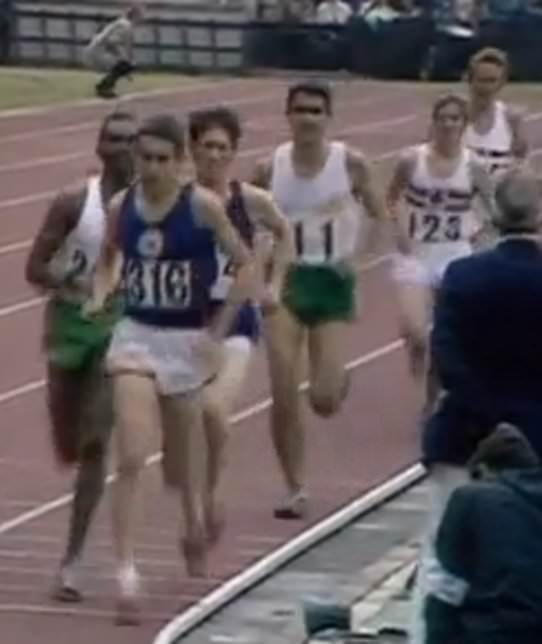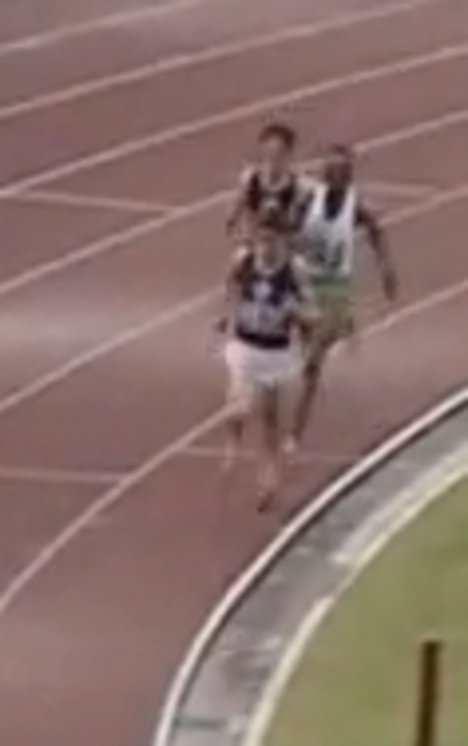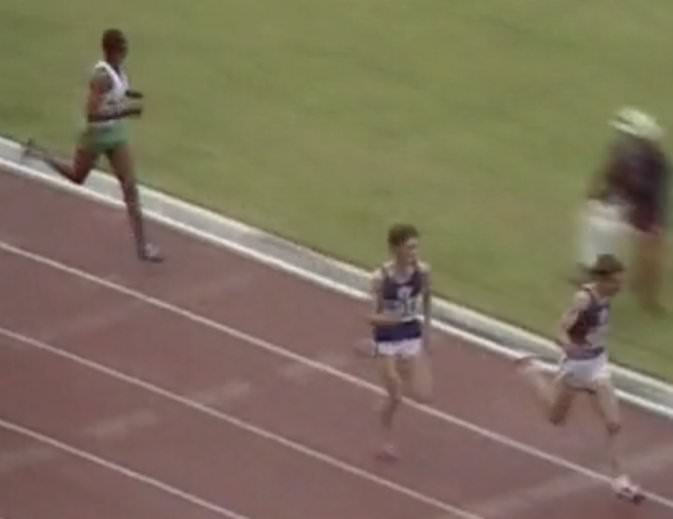Clarke v Keino v Stewart v McCafferty v Rushmer
5,000, Commonwealth Games, 1970
Meadowbank Stadium, Edinburgh, Scotland
Great Races # 22
Prospects
This 5,000 race had all the qualities of a Great Race. It took place in a major games, it fielded some of the world’s finest middle-distance runners, it recorded four of eight all-time fastest clockings, it involved some intriguing tactics and it ended up with a very exciting last two laps. Roberto Quercetani considered that this race had “hottest finish in the history of the event.” (Track & Field News, July, 1970)
 |
| Two laps to go. Mccafferty leads from Stewart, Keino,Clarke, Taylor and Rushmer. |
The field was comprised of three Scots, three Englishmen, two Kenyans, two New Zealanders and one runner each from Australia, Canada, Northern Ireland and Wales. Most prominent were two veterans from the 1964 Olympic final, Ron Clarke and Jipchoge Keino. They both brought a wealth of experience and had both set 5,000 WRs in 1965. Keino, the reigning Olympic 1,500 champion, had already won the 1,500 in these games, decimating the field three days previously. Clarke, who had lowered the 5,000 WR by 18.4 seconds and the 10,000 WR by 39.4 seconds, was running well, but he had been beaten in the 10,000 a week earlier. This race was regarded as his last chance to win a gold medal in a major games.
There were young runners ready to challenge these two giants of middle-distance. England had two fine ones in Allan Rushmer and Dick Taylor. Taylor had the world’s fastest time of the year (13:26.2); Rushmer had represented Great Britain in the Mexico Olympics and had clocked a fast 13:37 in June. The Scottish runners were just as impressive with Ian Stewart, Ian McCafferty and 10,000 winner Lachie Stewart. Ian Stewart was the 5,000 reigning European Champion, while McCafferty had run 13:29.6 in June behind Taylor’s 13:26.2. Finally there were two potential winners in Dick Quax, who had given Keino a great races in the 1,500, and John Ngeno of Kenya, who had finished a good sixth in the 10,000.
Competitor Dick Taylor summed up the prospects of this race: “Everyone will be in there fighting and the possibilities of what could happen are so many it’s frightening. I don’t think I dare pick a winner for certainty. It should be a classic.” (Times, July, 1970)
Tactics
 |
| One lap to go. Stewart leads with Keino onhis shoulder and McCafferty tucked in behind.Clarke is starting to lose contact. |
Two of the main contenders were expected to push the pace, as they lacked the finishing kick needed to win a slow major race. Dick Taylor clearly decided that a fast race was his best chance. “I want them all shaken up, especially Keino,” Taylor told Neil Allen of The Times. It’s my only chance.” (July 25, 1970) Ron Clarke knew only too well that to win he would have to break away before the last lap. There was talk before the race of Clarke helping Taylor with the pace-making, but no special plans had been made. Ian Stewart saw Keino as the main danger; he planned to keep pushing the Kenyan so that he couldn’t control the race and wouldn’t have any reserves in the last 150m.
Race
After a very slow first lap of 70.8 led in part by a reluctant Rushmer, Taylor had to take the lead. He ran steady 64-second laps, passing 1,000 in 2:47.0 and 2,000 in 5:28.6 (13:41 speed). With two more laps of 63.4 and 63.6, Taylor’s tactic was beginning to work: he had only five with him--Stewart, Clarke, McCafferty, Rushmer and Ngeno.
But now Taylor slowed (64.8, 65.4, 66.2); 4,000 was reached in 10:52 (13:35 speed). It was significant that Clarke did not take over to maintain a fast pace; he was as vulnerable as Taylor in a fast finish. As the pace gradually slowed, the pressure increased for someone to make a move. And it was McCafferty who finally charged into the lead with 870m left. Stewart too had been considering a move: “I remember thinking ‘I’m glad somebody else had gone now rather than me.’” (Jon Wigley, Athletics Weekly) McCafferty’s increased pace left all but Keino and Stewart behind. Clarke was trying to hold on, but it was now really a three-man race: two Scots against a Kenyan.
 |
| On the crown of the last bend.McCafferty, lying third, is about tomake his move. |
McCafferty led until 550 to go, when Stewart took the lead. “We thought if I could keep Keino under pressure until 150m from the tape, I could possibly get him. And that is why I took off so early to really make him have to run hard rather than to let him decide ‘to go now.’” (Wigley, Athletics Weekly) Gradually accelerating all the time, Stewart passed the bell in 12:27.4, with McCafferty behind him and Keino on McCafferty’s shoulder. Right after the bell Keino moved up to Stewart’s shoulder; he looked in control. But Stewart kept upping the pace. This acceleration showed most on Clarke; he had been within 5m of the leaders at the bell, but he was almost 20m down by the time he entered the back straight.
Racing down the back straight at high speed, the leading trio kept the same positions: Stewart in the lead, Keino slightly wide on Stewart’s shoulder and McCafferty tucked in behind Stewart. At 200 Keino tried to make his move, but Stewart resisted, forcing Keino to tuck in behind him round the bend. McCafferty was still with them, staying close behind Keino, and just past the crown of the bend he made his move. It seemed almost impossible for him to overtake, for the front two were running so fast.
Nevertheless, McCafferty was past Keino by the time they hit the straight. At the same time Stewart began his final effort: “I came out of the bend, put my head down and started to go.” (Wigley, Athletics Weekly) Keino knew he was beaten and looked back to see how safe third place was. Meanwhile, McCafferty’s incredible sprint got him closer and closer to Stewart, despite the latter’s surge. With 50 to go it looked possible that McCafferty could get the gold. But at that point he ran out of steam, and his head started to rock from side to side.
 |
| 50m to go. McCafferty tries to catch Stewart.This is the closest he got. Meanwhile, Keino looks back. |
Stewart held his form to the tape for a glorious victory. He had run 13 seconds faster than ever before to clock the third fastest 5,000 time ever. It was a new European record. His last 1,000 took 2:30.8, his last lap was run in 55.4 and his last 200 in 26.4. McCafferty had come so close to him and so close to glory. He too was under the European record and beat his PB by over six seconds. Stewart and McCafferty became the second and third fastest 5,000 runners all-time.
Behind these two Scots, Keino still ran within 3.4 seconds of his PB—despite easing up in the last straight. And Rushmer ran brilliantly to beat Clarke for fourth with a seven-second PB. A tired-looking Clarke disappointed in fifth. As in the 10,000 he ran without the competitive flair expected in a major games. The early pacemaker Dick Taylor, with two spike injuries from his two previous Commonwealth races and maybe a little tired from his bronze-medal run in the 10,000, rounded off the first six.
1. Ian Stewart SCO 13:22.8; 2. Ian McCafferty SCO 13: 23.4; 3. Kip Keino KEN 13:27.6; 4. Allan Rushmer ENG 13:29.8; 5. Ron Clarke AUS 13:32.4; 6. Dick Taylor ENG 13:33.8.
Leave a Comment